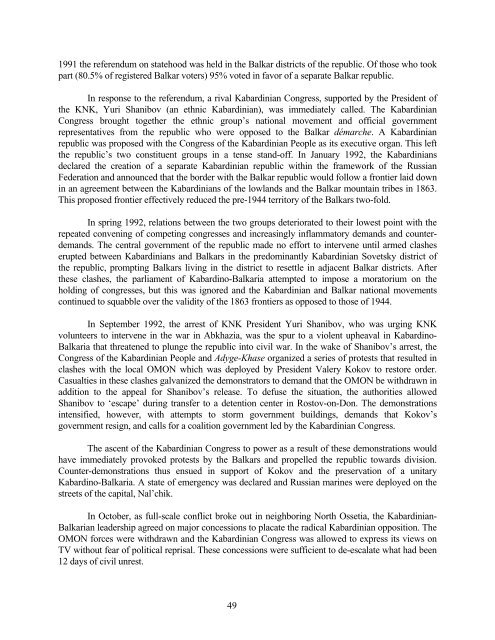RUSSIA'S TINDERBOX - Belfer Center for Science and International ...
RUSSIA'S TINDERBOX - Belfer Center for Science and International ...
RUSSIA'S TINDERBOX - Belfer Center for Science and International ...
Create successful ePaper yourself
Turn your PDF publications into a flip-book with our unique Google optimized e-Paper software.
1991 the referendum on statehood was held in the Balkar districts of the republic. Of those who took<br />
part (80.5% of registered Balkar voters) 95% voted in favor of a separate Balkar republic.<br />
In response to the referendum, a rival Kabardinian Congress, supported by the President of<br />
the KNK, Yuri Shanibov (an ethnic Kabardinian), was immediately called. The Kabardinian<br />
Congress brought together the ethnic group’s national movement <strong>and</strong> official government<br />
representatives from the republic who were opposed to the Balkar démarche. A Kabardinian<br />
republic was proposed with the Congress of the Kabardinian People as its executive organ. This left<br />
the republic’s two constituent groups in a tense st<strong>and</strong>-off. In January 1992, the Kabardinians<br />
declared the creation of a separate Kabardinian republic within the framework of the Russian<br />
Federation <strong>and</strong> announced that the border with the Balkar republic would follow a frontier laid down<br />
in an agreement between the Kabardinians of the lowl<strong>and</strong>s <strong>and</strong> the Balkar mountain tribes in 1863.<br />
This proposed frontier effectively reduced the pre-1944 territory of the Balkars two-fold.<br />
In spring 1992, relations between the two groups deteriorated to their lowest point with the<br />
repeated convening of competing congresses <strong>and</strong> increasingly inflammatory dem<strong>and</strong>s <strong>and</strong> counterdem<strong>and</strong>s.<br />
The central government of the republic made no ef<strong>for</strong>t to intervene until armed clashes<br />
erupted between Kabardinians <strong>and</strong> Balkars in the predominantly Kabardinian Sovetsky district of<br />
the republic, prompting Balkars living in the district to resettle in adjacent Balkar districts. After<br />
these clashes, the parliament of Kabardino-Balkaria attempted to impose a moratorium on the<br />
holding of congresses, but this was ignored <strong>and</strong> the Kabardinian <strong>and</strong> Balkar national movements<br />
continued to squabble over the validity of the 1863 frontiers as opposed to those of 1944.<br />
In September 1992, the arrest of KNK President Yuri Shanibov, who was urging KNK<br />
volunteers to intervene in the war in Abkhazia, was the spur to a violent upheaval in Kabardino-<br />
Balkaria that threatened to plunge the republic into civil war. In the wake of Shanibov’s arrest, the<br />
Congress of the Kabardinian People <strong>and</strong> Adyge-Khase organized a series of protests that resulted in<br />
clashes with the local OMON which was deployed by President Valery Kokov to restore order.<br />
Casualties in these clashes galvanized the demonstrators to dem<strong>and</strong> that the OMON be withdrawn in<br />
addition to the appeal <strong>for</strong> Shanibov’s release. To defuse the situation, the authorities allowed<br />
Shanibov to ‘escape’ during transfer to a detention center in Rostov-on-Don. The demonstrations<br />
intensified, however, with attempts to storm government buildings, dem<strong>and</strong>s that Kokov’s<br />
government resign, <strong>and</strong> calls <strong>for</strong> a coalition government led by the Kabardinian Congress.<br />
The ascent of the Kabardinian Congress to power as a result of these demonstrations would<br />
have immediately provoked protests by the Balkars <strong>and</strong> propelled the republic towards division.<br />
Counter-demonstrations thus ensued in support of Kokov <strong>and</strong> the preservation of a unitary<br />
Kabardino-Balkaria. A state of emergency was declared <strong>and</strong> Russian marines were deployed on the<br />
streets of the capital, Nal’chik.<br />
In October, as full-scale conflict broke out in neighboring North Ossetia, the Kabardinian-<br />
Balkarian leadership agreed on major concessions to placate the radical Kabardinian opposition. The<br />
OMON <strong>for</strong>ces were withdrawn <strong>and</strong> the Kabardinian Congress was allowed to express its views on<br />
TV without fear of political reprisal. These concessions were sufficient to de-escalate what had been<br />
12 days of civil unrest.<br />
49
















